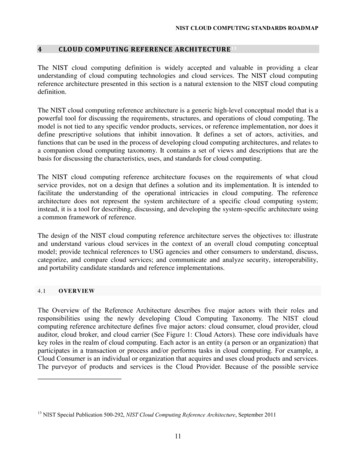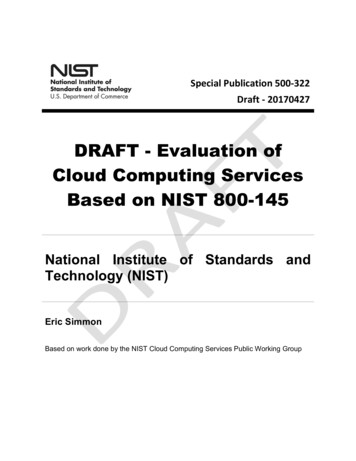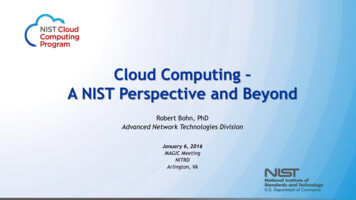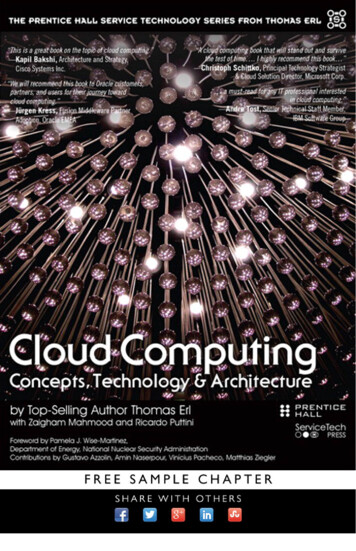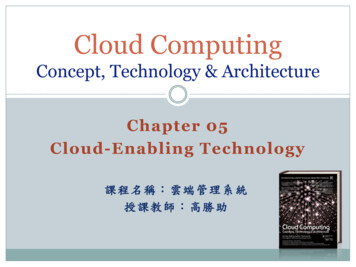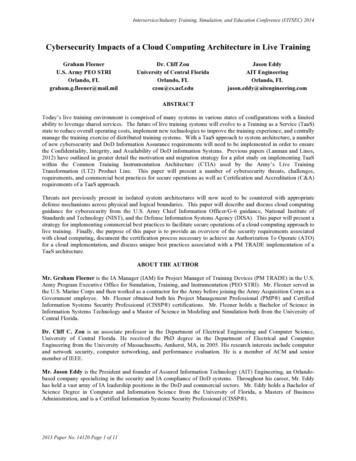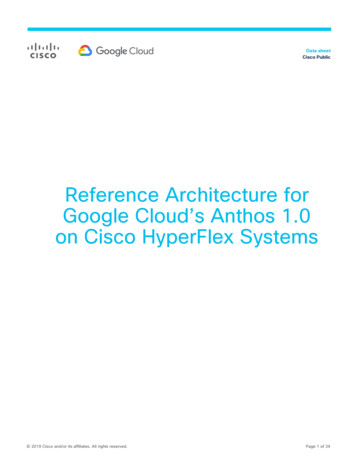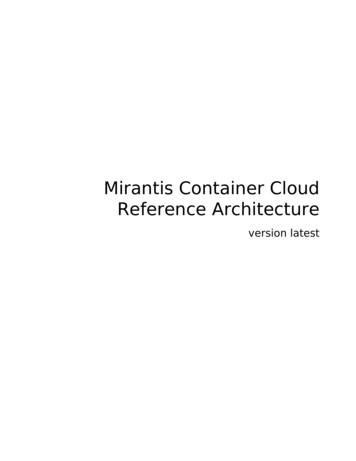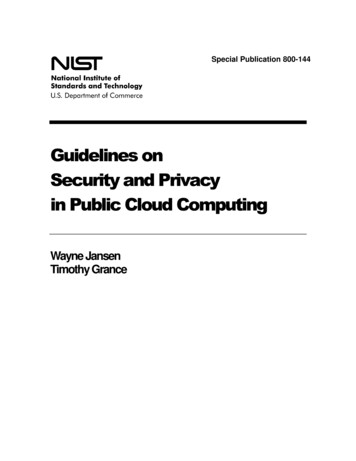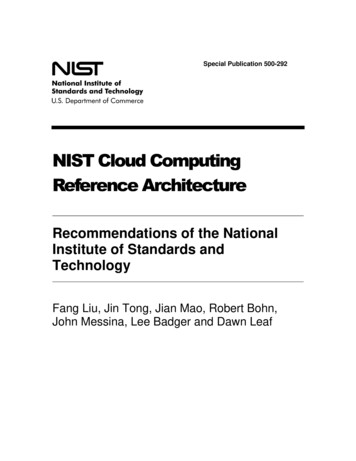
Transcription
Special Publication 500-292NIST Cloud ComputingReference ArchitectureRecommendations of the NationalInstitute of Standards andTechnologyFang Liu, Jin Tong, Jian Mao, Robert Bohn,John Messina, Lee Badger and Dawn Leaf
NIST Special Publication 500-292NIST Cloud Computing ReferenceArchitectureRecommendations of the NationalInstitute of Standards and TechnologyFang Liu, Jin Tong, Jian Mao, RobertBohn, John Messina, Lee Badger andDawn LeafInformation Techonology LaboratoryCloud Computing ProgramInformation Technology LaboratoryNational Institute of Standards and TechnologyGaithersburg, MD 20899-8930September 2011U.S. Department of CommerceRebecca M. Blank, Acting SecretaryNational Institute of Standards and TechnologyPatrick D. Gallagher, Under Secretary for Standardsand Technology and Directori
NIST SP 500-292NIST Cloud Computing Reference ArchitectureReports on Computer Systems TechnologyThe Information Technology Laboratory (ITL) at the National Institute of Standards and Technology(NIST) promotes the U.S. economy and public welfare by providing technical leadership for the nation‟smeasurement and standards infrastructure. ITL develops tests, test methods, reference data, proof ofconcept implementations, and technical analysis to advance the development and productive use ofinformation technology. ITL‟s responsibilities include the development of technical, physical,administrative, and management standards and guidelines for the cost-effective security and privacy ofsensitive unclassified information in Federal computer systems. This Special Publication 800-seriesreports on ITL‟s research, guidance, and outreach efforts in computer security and its collaborativeactivities with industry, government, and academic organizations.National Institute of Standards and Technology Special Publication 500-292Natl. Inst. Stand. Technol. Spec. Publ. 500-292, 35 pages (September 2011)Certain commercial entities, equipment, or materials may be identified in thisdocument in order to describe an experimental procedure or concept adequately.Such identification is not intended to imply recommendation or endorsement by theNational Institute of Standards and Technology, nor is it intended to imply that theentities, materials, or equipment are necessarily the best available for the purpose.ii
NIST SP 500-292NIST Cloud Computing Reference ArchitectureAcknowledgmentsThe authors, Fang Liu, Jin Tong, Jian Mao of Knowcean Consulting Inc. (services acquired via USNAVY SPAWAR contract), Robert Bohn, John Messina, Lee Badger, Dawn Leaf of the NationalInstitute of Standards and Technology (NIST), wish to thank their colleagues who reviewed drafts of thisdocument and contributed to its technical content. The authors gratefully acknowledge and appreciate thebroad contributions from members of the NIST Cloud Computing Reference Architecture and TaxonomyWorking Group and the Reference Architecture Analysis Team.Trademark InformationAll names are trademarks or registered trademarks of their respective owners.iii
NIST SP 500-292NIST Cloud Computing Reference ArchitectureTable of ContentsExecutive Summary . vi1.2.3.Introduction . 11.1Background . 11.2Objectives. 11.3How This Report Was Produced . 21.4Structure of This Report . 2Cloud Computing Reference Architecture: An Overview . 32.1The Conceptual Reference Model . 32.2Cloud Consumer. 52.3Cloud Provider . 72.4Cloud Auditor . 82.5Cloud Broker . 82.6Cloud Carrier . 82.7Scope of Control between Provider and Consumer . 9Cloud Computing Reference Architecture: Architectural Components . 103.1Service Deployment . 103.2Service Orchestration . 123.3Cloud Service Management . 143.3.1Business Support . 143.3.2Provisioning and Configuration. 153.3.3Portability and Interoperability . 153.43.4.1Cloud Service Model Perspectives . 163.4.2Implications of Cloud Deployment Models . 163.4.3Shared Security Responsibilities . 163.54.Security . 15Privacy . 17Cloud Taxonomy . 18Appendix A: Cloud Taxonomy Terms and Definitions . 20Appendix B: Examples of Cloud Services . 24Appendix C: Acronyms . 26Appendix D: References . 27iv
NIST SP 500-292NIST Cloud Computing Reference ArchitectureList of FiguresFigure 1: The Conceptual Reference Model . 3Figure 2: Interactions between the Actors in Cloud Computing . 4Figure 3: Usage Scenario for Cloud Brokers . 4Figure 4: Usage Scenario for Cloud Carriers . 5Figure 5: Usage Scenario for Cloud Auditors . 5Figure 6: Example Services Available to a Cloud Consumer . 6Figure 7: Cloud Provider - Major Activities . 7Figure 8: Scope of Controls between Provider and Consumer . 9Figure 10: On-site Private Cloud .10Figure 11: Out-sourced Private Cloud .11Figure 12: On-site Community Cloud .11Figure 13: Outsourced Community Cloud .12Figure 14: Hybrid Cloud .12Figure 15: Cloud Provider - Service Orchestration .13Figure 16: Cloud Provider - Cloud Service Management.14Figure 17: Cloud Taxonomy .19List of TablesTable 1: Actors in Cloud Computing . 4v
NIST SP 500-292NIST Cloud Computing Reference ArchitectureExecutive SummaryThe adoption of cloud computing into the US Government (USG) and its implementation depend upon avariety of technical and non-technical factors. A fundamental reference point, based on the NISTdefinition of Cloud Computing, is needed to describe an overall framework that can be used governmentwide. This document presents the NIST Cloud Computing Reference Architecture (RA) and Taxonomy(Tax) that will accurately communicate the components and offerings of cloud computing. The guidingprinciples used to create the RA were 1) develop a vendor-neutral architecture that is consistent with theNIST definition and 2) develop a solution that does not stifle innovation by defining a prescribedtechnical solution. This solution will create a level playing field for industry to discuss and compare theircloud offerings with the US Government (USG). The resulting reference architecture and taxonomy forcloud computing was developed as an Actor/Role based model that lays out the central elements of cloudcomputing for Federal CIOs, Procurement Officials and IT Program Managers. The cloudscape is openand diversified and the accompanying taxonomy provides a means to describe it in an unambiguousmanner. The RA is presented in two parts: a complete overview of the actors and their roles and thenecessary architectural components for managing and providing cloud services such as servicedeployment, service orchestration, cloud service management, security and privacy. The Taxonomy ispresented in its own section and appendices are dedicated to terms and definitions and examples of cloudservices.The Overview of the Reference Architecture describes five major actors with their roles & responsibilitiesusing the newly developed Cloud Computing Taxonomy. The five major participating actors are theCloud Consumer, Cloud Provider, Cloud Broker, Cloud Auditor and Cloud Carrier. These coreindividuals have key roles in the realm of cloud computing. For example, a Cloud Consumer is anindividual or organization that acquires and uses cloud products and services. The purveyor of productsand services is the Cloud Provider. Because of the possible service offerings (Software, Platform orInfrastructure) allowed for by the cloud provider, there will be a shift in the level of responsibilities forsome aspects of the scope of control, security and configuration. The Cloud Broker acts as theintermediate between consumer and provider and will help consumers through the complexity of cloudservice offerings and may also create value-added cloud services as well. The Cloud Auditor provides avaluable inherent function for the government by conducting the independent performance and securitymonitoring of cloud services. The Cloud Carrier is the organization who has the responsibility oftransferring the data akin to the power distributor for the electric grid.The Architectural Components of the Reference Architecture describes the important aspects of servicedeployment and service orchestration. The overall service management of the cloud is acknowledged asan important element in the scheme of the architecture. Business Support mechanisms are in place torecognize customer management issues like contracts, accounting and pricing and are vital to cloudcomputing. A discussion on Provisioning and Configuration points out the requirements for cloudsystems to be available as needed, metered and have proper SLA management in place. Portability andInteroperability issues for data, systems and services are crucial factors facing consumers in adopting thecloud are also undertaken here. Consumers need confidence in moving their data and services acrossmultiple cloud environments.As a major architectural component of the cloud, Security and Privacy concerns need to be addressed andthere needs to be a level of confidence and trust in order to create an atmosphere of acceptance in thecloud‟s ability to provide a trustworthy and reliable system. Security responsibilities, securityconsideration for different cloud service models and deployment models are also discussed.vi
NIST SP 500-2921.Introduction1.1BackgroundNIST Cloud Computing Reference ArchitectureThe National Institute of Standards and Technology (NIST) has been designated by Federal ChiefInformation Officer (CIO) Vivek Kundra with technical leadership for US government (USG) agencyefforts related to the adoption and development of cloud computing standards. The goal is to acceleratethe federal government‟s adoption of secure and effective cloud computing to reduce costs and improveservices. The NIST strategy is to build a USG Cloud Computing Technology Roadmap which focuses onthe highest priority USG cloud computing security, interoperability and portability requirements, and tolead efforts to develop standards and guidelines in close consultation and collaboration with standardsbodies, the private sector, and other stakeholders.The NIST cloud computing program was formally launched in November 2010 to support the federalgovernment effort to incorporate cloud computing as a replacement for, or enhancement to, traditionalinformation system and application models where appropriate. The NIST cloud computing programoperates in coordination with other USG-wide cloud computing efforts (CIO Council/ISIMC, etc.) and isintegrated with the Federal 25-point IT Management Reform Plan1 and Federal Cloud ComputingStrategy2. NIST has created the following working groups in order to provide a technically-orientedstrategy and standards-based guidance for the federal cloud computing implementation effort:Cloud Computing Target Business Use Cases Working GroupCloud Computing Reference Architecture and Taxonomy Working GroupCloud Computing Standards Roadmap Working GroupCloud Computing SAJACC Working GroupCloud Computing Security Working Group1.2ObjectivesThe NIST cloud computing definition [1] is widely accepted as a valuable contribution toward providinga clear understanding of cloud computing technologies and cloud services. It provides a simple andunambiguous taxonomy of three service models available to cloud consumers: cloud software as a service(SaaS), cloud platform as a service (PaaS), and cloud infrastructure as a service (IaaS). It alsosummarizes four deployment models describing how the computing infrastructure that delivers theseservices can be shared: private cloud, community cloud, public cloud, and hybrid cloud. Finally, the NISTdefinition also provides a unifying view of five essential characteristics that all cloud services exhibit: ondemand self-service, broad network access, resource pooling, rapid elasticity, and measured service.These services and their delivery are at the core of cloud computing. In the cloud computing model, theprimary focus is a more economic method of providing higher quality and faster services at a lower costto the users. In the traditional IT service delivery model, there is a large emphasis on procuring,maintaining and operating the necessary hardware and related infrastructure. The cloud computing modelenables CIOs, IT project managers and procurement officials to direct their attention to innovative servicecreation for the customers.In order to have successful service delivery, the USG needs to ensure the reliability in the delivery ofproducts and processes. By ensuring durable and proper standards in place for cloud computing insecurity, data portability and service interoperability, the USG will have the additional confidence needed1Office of Management and Budget, U.S. Chief Information Officer Vivek Kundra, “25 Point Implementation Plan to ReformFederal Information Technology Management”, December 2010. onPlan-to-Reform-Federal%20IT.pdf2Office of Management and Budget, U.S. Chief Information Officer Vivek Kundra, “Federal Cloud Computing Strategy”,February 2011. ng-Strategy.pdf1
NIST SP 500-292NIST Cloud Computing Reference Architectureto move their applications into the cloud. The necessary standards will also promote an even playing fieldamong cloud service providers and give the cloud service consumers a number of different options in themarketplace and the confidence that their data and applications will operate on any cloud.Standards for cloud computing are the overall goal of the NIST cloud computing program; the logical stepto take after the formation of the NIST cloud computing definition is to create an intermediate referencepoint from where one can frame the rest of the discussion about cloud computing and begin to identifysections in the reference architecture in which standards are either required, useful or optional. The NISTcloud computing reference architecture presented in this document is a logical extension to the NISTcloud computing definition. It is a generic high-level conceptual model that is an effective tool fordiscussing the requirements, structures, and operations of cloud computing. The model is not tied to anyspecific vendor products, services or reference implementation, nor does it define prescriptive solutionsthat inhibit innovation. It defines a set of actors, activities and functions that can be used in the process ofdeveloping cloud computing architectures, and relates to a companion cloud computing taxonomy. Thereference architecture contains a set of views and descriptions that are the basis for discussing thecharacteristics, uses and standards for cloud computing. This actor/role based model is intended to servethe expectations of the stakeholders by allowing them to understand the overall view of roles andresponsibilities in order to assess and assign risk.The NIST cloud computing reference architecture focuses on the requirements of “what” cloud servicesprovide, not a “how to” design solution and implementation. The reference architecture is intended tofacilitate the understanding of the operational intricacies in cloud computing. It does not represent thesystem architecture of a specific cloud computing system; instead it is a tool for describing, discussing,and developing a system-specific architecture using a common framework of reference.The design of the NI
May 01, 2010 · Cloud Consumer, Cloud Provider, Cloud Broker, Cloud Auditor and Cloud Carrier. These core individuals have key roles in the realm of cloud computing. For example, a Cloud Consumer is an individual or organization that acquires and uses cloud products and services. The purveyor of products and
